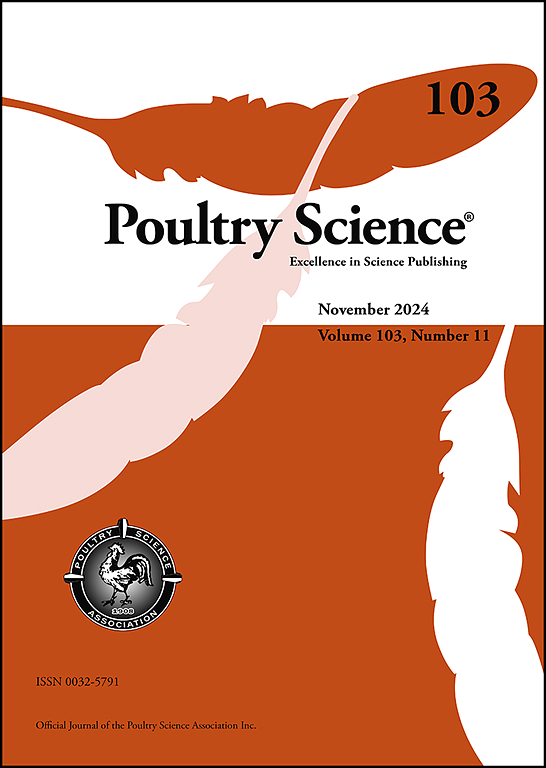Effects of dietary supplementation with a polyherbal based product on sporozoites viability and on growth performance, lesion score, gut permeability, oocyst shedding count, tight junction, pro-inflammatory cytokine, and antioxidant enzyme in broiler chickens challenged with Eimeria spp
IF 3.8
1区 农林科学
Q1 AGRICULTURE, DAIRY & ANIMAL SCIENCE
引用次数: 0
Abstract
Two in vivo and in vitro studies were conducted to investigate the effects of supplementation of a natural polyherbal mixture (PHM) manufactured from selected herbs in broiler chickens challenged with coccidiosis. For the in vitro trial, E. tenella and E. maxima sporozoites were used to test how PHM affected sporozoites viability at 24, 48, and 72 h. The treatments were as follows: negative control with phosphate buffered saline (NC-PBS), solvent control containing 1 % dimethyl sulfoxide (DMSO), salinomycin at 12 mg/kg with 1 % DMSO in PBS (SAL), and 500 mg/kg PHM in PBS (PHM). For the in vivo trial, a total of 288 0-day-old male Cobb 500 were randomly distributed into 3 treatments with 8 replicates, and study lasted for 28 days. Treatments were as follows: non-challenge control with a basal diet (NC), Eimeria spp. challenge with a basal diet (CC), and Eimeria spp. challenge with a basal diet containing 500 mg/kg of the PHM (PHM). Chickens in challenged groups were inoculated with 62,500 oocyst of E. acervulina, 12,500 oocyst of E. maxima and E. tenella on 14 days. In vitro results showed that PHM increased (P < 0.001) a Eimeria sporozoite reduction percentage. As for in vivo results, the PHM group had similar body weight gain, feed intake, and feed efficiency compared to the NC group. The use of PHM reduced fecal oocyst counts of E. tenella and E. maxima from 6 to 9 days post inoculation (DPI; P < 0.05). Moreover, PHM supplementation decreased duodenum and ceca lesion scores (P < 0.001). The PHM group also had reduced expression levels of claudin 1 (CLDN-1), interleukin 1 beta (IL-1β) and tumor necrosis factor alpha (TNF-α) in the jejunum compared to the CC group (P < 0.01). In conclusion, the supplementation with 500 mg/kg of polyherbal mixture both in vitro and in vivo reduced the viability of E. tenella and E. maxima sporozoites, and this could explain that PHM effectively mitigated negative effects caused by the challenge with Eimeria spp., suggesting that it could be a dietary strategy to improve performance and gut health in broilers under coccidiosis.
求助全文
约1分钟内获得全文
求助全文
来源期刊

Poultry Science
农林科学-奶制品与动物科学
CiteScore
7.60
自引率
15.90%
发文量
0
审稿时长
94 days
期刊介绍:
First self-published in 1921, Poultry Science is an internationally renowned monthly journal, known as the authoritative source for a broad range of poultry information and high-caliber research. The journal plays a pivotal role in the dissemination of preeminent poultry-related knowledge across all disciplines. As of January 2020, Poultry Science will become an Open Access journal with no subscription charges, meaning authors who publish here can make their research immediately, permanently, and freely accessible worldwide while retaining copyright to their work. Papers submitted for publication after October 1, 2019 will be published as Open Access papers.
An international journal, Poultry Science publishes original papers, research notes, symposium papers, and reviews of basic science as applied to poultry. This authoritative source of poultry information is consistently ranked by ISI Impact Factor as one of the top 10 agriculture, dairy and animal science journals to deliver high-caliber research. Currently it is the highest-ranked (by Impact Factor and Eigenfactor) journal dedicated to publishing poultry research. Subject areas include breeding, genetics, education, production, management, environment, health, behavior, welfare, immunology, molecular biology, metabolism, nutrition, physiology, reproduction, processing, and products.
 求助内容:
求助内容: 应助结果提醒方式:
应助结果提醒方式:


